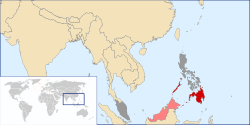Bangsamoro Republik
This article may rely excessively on sources too closely associated with the subject, potentially preventing the article from being verifiable and neutral. (October 2015) |
United Federated States of Bangsamoro Republik | |||||||||
|---|---|---|---|---|---|---|---|---|---|
| 2013 | |||||||||
|
Flag | |||||||||
 Maximum area claimed by the Bangsamoro Republik | |||||||||
| Status | Unrecognized state | ||||||||
| Capital | Davao City[1] (de jure) Zamboanga City (de facto) | ||||||||
| Largest city | Davao City | ||||||||
| Demonym(s) | Bangsamoro | ||||||||
| Government | Federal presidential constitutional republic[2] | ||||||||
| President | |||||||||
• 2013 | Nur Misuari | ||||||||
| Independence from the Philippines | |||||||||
| History | |||||||||
• Declared | July 27, 2013 | ||||||||
• Defeated in Zamboanga | September 28, 2013 | ||||||||
| Time zone | UTC+8 | ||||||||
| Drives on | Right | ||||||||
| |||||||||
The Bangsamoro Republik, officially the United Federated States of Bangsamoro Republik (UFSBR),[3] was a short-lived, self-proclaimed, unrecognized breakaway state in the Philippines. Nur Misuari, chairman of the Moro National Liberation Front, issued the Proclamation of Bangsamoro Independence on July 27, 2013 in Talipao, Sulu and declared the capital of Bangsamoro to be Davao City.[4]
History
[edit]According to Misuari, the republic's territory encompasses the islands of Basilan, Mindanao, Palawan, Sulu and Tawi-Tawi[3] where he falsely claimed were the traditional "Bangsamoro" territories. Majority of the places he mentioned were territories belonging to non-Muslim indigenous peoples, and not "Moro" people. Misuari's legal counsel, Emmanuel Fontanilla, later stated that their "state" will also encompass the Malaysian states of Sabah and Sarawak, whose population are not majority-Muslims.[5][6]
Mosuari falsely claimed that his declaration of independence was made under the authority of the United Nations General Assembly 1514 resolution of 1960, which he alleges would grant independence to all colonized countries. The UN resolution never mentioned the territory he referred to as "Bangsamoro".[better source needed][7] Due to Misuari's unilateral declaration, the conflict escalated into the Zamboanga City crisis.[8] The MNLF, the group which proclaimed Bangsamoro, was an observer in the Organisation of Islamic Cooperation when the declaration was made.
As of September 28, 2013, with the defeat in Zamboanga City by the Philippine government, the MNLF no longer controls any territory openly anywhere and the Bangsamoro Republic has been officially debilitated, ending the war.
Etymology
[edit]The term Bangsamoro comes from combining the word bangsa, meaning nation or people, and the Spanish word moro, which was originally applied to the Moors that ruled Spain prior to the Reconquista, and was subsequently applied to predominantly Muslim Malay tribes.
Background
[edit]Earlier declarations
[edit]An independent state of Bangsamoro Republik was first declared on April 28, 1974,[9][10] two months after the siege of Jolo, Sulu after the MNLF first attempted to raise their flag.[11]
Zamboanga City crisis
[edit]MNLF commander Asamin Hussin stated in September 2013 that his group would only release some 200 civilian hostages held in Barangay Kasanyangan once they are allowed to proceed to Zamboanga city hall and hoist their flag in front of it.[8] During the crisis, the MNLF did not manage to gain de facto control [according to whom?] of three districts of Zamboanga City.[better source needed][12][13]
Present
[edit]As of 2014[update], Nur Misuari was the UFSBR's Interim President according to the MNLF.[14] A government in exile for the Bangsamoro has also been considered by Misuari.[5]
See also
[edit]- Flag of the Bangsamoro Republik
- Moro National Liberation Front
- Moro Islamic Liberation Front
- Framework Agreement on the Bangsamoro
- Peace process with the Bangsamoro in the Philippines
- Bangsamoro Organic Law
References
[edit]- ^ ""BRING BANGSAMORO QUESTION TO UN," MNLF VICE-CHAIRMAN OLAMIT TO APPEAL TO OIC". mnlfnet.com. Moro National Liberation Front (Misuari faction). June 25, 2015. Retrieved June 25, 2015.
- ^ "MNLF returns to rebellion | Headlines, News, The Philippine Star". philstar.com. August 16, 2013. Retrieved September 8, 2013.
- ^ a b "Bangsamoro Constitution: Road map to Independence and National self-determination". MNLF official website. August 23, 2013. Archived from the original on September 13, 2013. Retrieved September 8, 2013.
- ^ "WHO IS AFRAID OF MINDANAO INDEPENDENCE?". August 14, 2013. Archived from the original on September 15, 2013. Retrieved November 19, 2013.
- ^ a b "Misuari declares independence of Mindanao, southern Philippines". Gulf News. August 16, 2013. Retrieved September 8, 2013.
- ^ Roel Pareño, The Philippine Star (August 16, 2013). "MNLF returns to rebellion". ABS-CBN News. Retrieved September 8, 2013.
- ^ "Nur declares independence of 'Bangsamoro Republik'". Philippine Star. August 15, 2013. Retrieved September 8, 2013.
- ^ a b "MNLF wants flag hoisted in Zamboanga city hall". ABS-CBN News. September 9, 2013. Retrieved September 9, 2013.
- ^ W.K. Che Man. "Muslim Separatism: The Moros of Southern Philippines and the Malays of Southern Thailand". Quezon City: Ateneo de Manila University Press, 1974.
- ^ Abinales, Patricio. N., et al. "State and Society in the Philippines". Oxford: Rowman & Littlefield Publishers, Inc., 2005.
- ^ Ben Cal (September 11, 2013). "MNLF's first try to raise flag was 39 years ago". Manila Bulletin. Retrieved January 13, 2014.
- ^ "Houses on fire as fighting erupts in southern Philippines". Reuters.
- ^ "Malaysian Marwan believed to mastermind latest bomb attacks in south Philippines". The Star. Archived from the original on November 10, 2013. Retrieved September 16, 2013.
- ^ "CHAIRMAN MISUARI'S MESSAGE ON THE CELEBRATION OF THE 46th ANNIVERSARY OF THE BANGSAMORO FREEDOM DAY". mnlfnet.com. Moro National Liberation Front (Misuari faction). March 18, 2014. Retrieved March 18, 2014.

